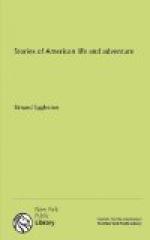When Mr. Clark found his son trying to make a telescope out of the pieces of a bell, he became interested in telescopes. He studied all about them in order to help the boy with his work. He helped his son grind the metal disc into a concave mirror; that is, a mirror that is a little dish-shaped. With this they made a telescope with which they could see the rings of Saturn, and the little moons that revolve round Jupiter.
After Mr. Clark had made this little telescope, he made larger reflecting telescopes that were very powerful. But he found that no telescope with a mirror in it could be very good.
He now said to his son that they would make a refracting telescope; that is, one in which no mirror is used, but which brings the distant stars to the sight by the light shining through lenses. Lenses are large glasses that are regularly thicker in one part than in another. The glasses you see in spectacles are small lenses.
George Clark, the son, told his father that the books said that the grinding of such glasses was very difficult. Mr. Clark would not give it up because it was hard. He liked to do hard things. He had already spent a great part of his money trying to make good reflecting telescopes; but he made up his mind to give them up, and try to make a better kind. He first looked through the great telescope just put up for Harvard College. The large lens in this telescope was not perfect, and Mr. Clark’s eye was so good that he could see what the small fault was. When he heard that twelve thousand dollars had been paid for this glass, he was encouraged to try to make such lenses. But there was nobody in this country who could show him how to do it.
He first got some poor lenses out of old telescopes. These he worked over, and made them better. By this means he learned how to do it. Then he got some discs of glass and made some new lenses. These were the best ever made in this country. But he was not satisfied. He kept on making better and larger lenses. With one of these he discovered two double stars, as they are called. These had never been seen to be double before.
But nobody in America would believe that some of the best telescopes in the world were made in this country, for even the English astronomers had to get their telescopes in Germany.
With one of his telescopes, larger than any he had made before, Mr. Clark now made a new discovery. He wrote about this to an English astronomer named Dawes. Mr. Dawes thought that a telescope that could make such a discovery would be worth having, so he bought the large lens out of this new telescope. Then he bought other glasses from Mr. Clark, and sold them again to other astronomers. In this way Mr. Clark became famous in England.
[Illustration: Telescopic View of the Moon.]
Mr. Clark had given up painting. He put his whole heart into making the best telescopes in the world. He went to England and saw the great astronomers, and looked through their telescopes.




